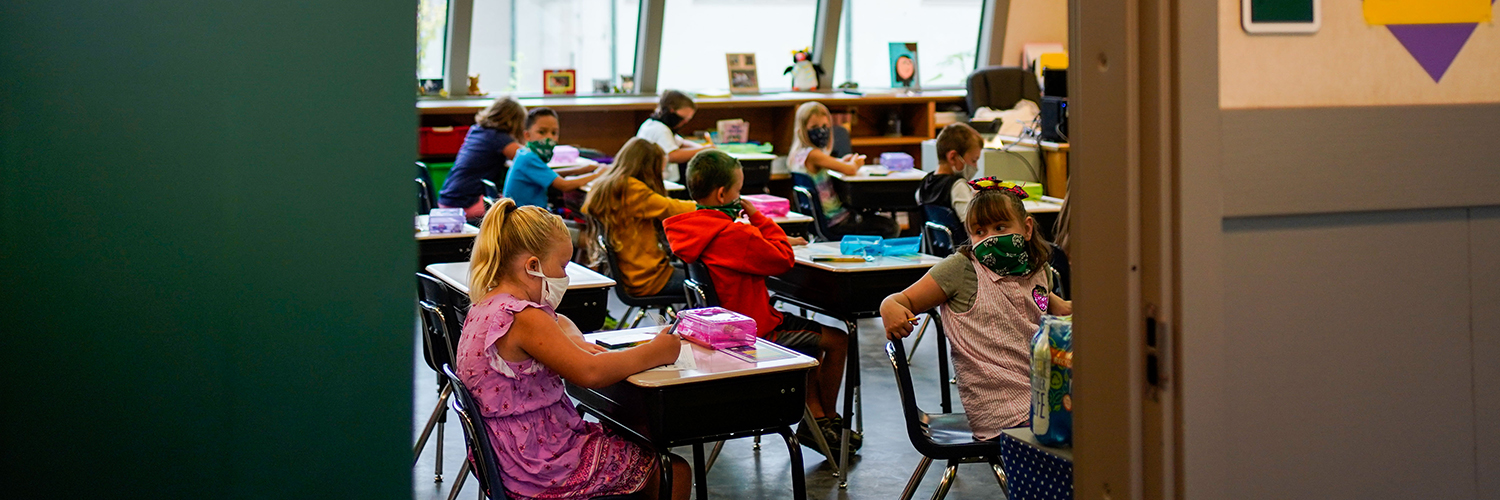
<p>Students in Darsi Greens second grade class at Weaverville Elementary School on the first day on returning to in-person instruction on Monday, August 17, 2020 in Weaverville, California. The Trinity Alps Unified School District reopened amid the coronavirus pandemic, resuming in-person classroom instruction. (Kent Nishimura / Los Angeles Times via Getty Images)</p>
Changes to school enrollment and poverty as a result of the pandemic have complicated states’ attempts to equitably fund school districts. Many state legislatures are trying to adjust their formulas ahead of the 2021–22 school year. Key questions vary by funding formula, as well as by other state factors, such as the availability of online charter options and the availability of supplemental allocations for high-need students.
We summarize current policy discussions on K–12 funding solutions for the 2021–22 school year, highlighting ways states are working to answer funding questions during this legislative session.
Because most state funding formulas allocate dollars based on the number of students attending or enrolling in each district in the previous year, the overall decline in student numbers during the pandemic could lead to funding reductions. The figure below illustrates how this could happen. In this sample scenario, a very large (20 percent) enrollment decline in 2020-21 yields a substantial decrease in funding in 2021–22, which is exacerbated if withdrawn students return as the pandemic subsides.

Although real-world enrollment declines have not been as large (averaging 4–5 percent across a state), declines vary substantially across districts, and prekindergarten and kindergarten cohorts have exhibited much steeper drop-offs and have yielded other questions for states.
How do states using attendance-based funding allocations adapt?
Seven states, including California, New York, and Texas, calculate funding allocations using average daily attendance. Because districts with lower rates of attendance also tend to serve larger shares of low-income students, states that use average daily allowance risked underfunding districts with higher levels of need even in before the pandemic. This risk could be exacerbated during the pandemic, as low-income students may be less likely to access remote learning or attend in-person classes.
Policymakers have proposed different approaches for resolving issues around attendance-based funding. In Florida, district leaders have been charged with trying to find and ensure enrollment of missing students. Florida also introduced temporary changes to allow funding based on projected, rather than actual, student enrollment, but it is unclear how long this change will last.
Similarly, Texas implemented temporary provision allowing for funding based on projected enrollment, and state leaders are assessing how to fund districts that have seen attendance declines. Texas state representative Gina Hinojosa has filed a bill to fund districts using enrollment, rather than attendance.
In states with robust virtual schools, how many students will stay online?
During the pandemic, enrollment in online-only schools has increased substantially. These schools are typically run by a charter organization. In states with robust online charter options—such as Oklahoma, where enrollment in the state’s largest virtual charter now stands at around 60,000 students—it is unclear how many students will return to their local in-person options this fall.
How can states target funding to districts with the most need?
State policymakers are clearly trying to acknowledge—and potentially remedy—funding changes caused by pandemic-induced changes in enrollment. Policymakers in some states, such as New Mexico and Washington, have considered policies that functionally holding districts harmless for enrollment losses. Others, such as Massachusetts and Arizona, have maintained funding tied to pandemic-year enrollment, but may also rely on preexisting rules that mitigate funding losses or additional infusions of funding aimed at helping districts serving low-income families.
State policy changes to funding formulas have focused on accounting for pandemic-induced changes in enrollment. However, fewer states have tackled how the pandemic may have affected measures of student poverty.
Because of flexibilities in the delivery of school meals during the pandemic, counts of students from low-income families may be unreliable this year. New Hampshire policymakers have introduced a bill that holds districts harmless both for changes in enrollment and a 25 percent drop in free- and reduced-price lunch participation. Colorado policymakers have introduced a similar bill. Other states have encouraged districts and schools to continue to sign up families through the school year.
As the pandemic begins to recede, schools will need robust funding to invest in initiatives that mitigate learning loss in the 2021–22 school year. Mitigating harm from changes in enrollment and counts of students in poverty is a key first step toward helping schools get students back on track.
Let’s build a future where everyone, everywhere has the opportunity and power to thrive
Urban is more determined than ever to partner with changemakers to unlock opportunities that give people across the country a fair shot at reaching their fullest potential. Invest in Urban to power this type of work.